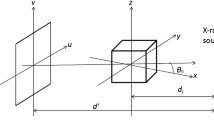Summary
A common task in medical image analysis is the alignment of data from different sources, e.g., X-ray images and computed tomography (CT) data. Such a task is generally known as registration. We demonstrate the applicability of automatic differentiation (AD) techniques to a class of 2D/3D registration problems which are highly computationally intensive and can therefore greatly benefit from a parallel implementation on recent graphics processing units (GPUs). However, being designed for graphics applications, GPUs have some restrictions which conflict with requirements for reverse mode AD, in particular for taping and TBR analysis. We discuss design and implementation issues in the presence of such restrictions on the target platform and present a method which can register a CT volume data set (512 × 512 × 288 voxels) with three X-ray images (512 × 512 pixels each) in 20 seconds on a GeForce 8800GTX graphics card.
Access this chapter
Tax calculation will be finalised at checkout
Purchases are for personal use only
Preview
Unable to display preview. Download preview PDF.
Similar content being viewed by others
References
Bauer, C., Frink, A., Kreckel, R.: Introduction to the GiNaC framework for symbolic computation within the C++ programming language. J. Symb. Comput. 33(1), 1–12 (2002). http://www.ginac.de
Baur, W., Strassen, V.: The complexity of partial derivatives. Theoretical Computer Science 22(3), 317–330 (1983)
Bischof, C., Khademi, P., Mauer, A., Carle, A.: Adifor 2.0: Automatic differentiation of Fortran 77 programs. IEEE Computational Science & Engineering 3(3), 18–32 (1996)
Bischof, C.H., Bücker, H.M.: Computing derivatives of computer programs. In: Modern Methods and Algorithms of Quantum Chemistry: Proceedings, Second Edition, NIC Series, vol. 3, pp. 315–327. NIC-Directors, Jülich (2000)
Chan, T., Shen, J.: Image Processing and Analysis – Variational, PDE, Wavelet, and Stochastic Methods. SIAM, Philadelphia (2005)
Corliss, G.F., Griewank, A.: Operator overloading as an enabling technology for automatic differentiation. Tech. Rep. MCS-P358-0493, Mathematics and Computer Science Division, Argonne National Laboratory (1993)
Faure, C., Naumann, U.: Minimizing the tape size. In: G. Corliss, C. Faure, A. Griewank, L. Hascoët, U. Naumann (eds.) Automatic Differentiation of Algorithms: From Simulation to Optimization, Computer and Information Science, chap. 34, pp. 293–298. Springer, New York, NY (2002)
Giering, R., Kaminski, T., Slawig, T.: Applying TAF to a Navier-Stokes solver that simulates an euler flow around an airfoil. Future Generation Computer Systems 21(8), 1345–1355 (2005)
Gong, R.H., Abolmaesumi, P., Stewart, J.: A Robust Technique for 2D-3D Registration. In: Engineering in Medicine and Biology Society, pp. 1433–1436 (2006)
Griewank, A.: The chain rule revisited in scientific computing. SINEWS: SIAM News 24(4), 8–24 (1991)
Griewank, A.: Evaluating derivatives: Principles and techniques of algorithmic differentiation. Society for Industrial and Applied Mathematics, Philadelphia, PA, USA (2000)
Griewank, A., Juedes, D., Utke, J.: ADOL–C, A package for the automatic differentiation of algorithms written in C/C++. ACM Trans. Math. Software 22(2), 131–167 (1996)
Hartley, R., Zisserman, A.: Multiple View Geometry in Computer Vision, second edn. Cambridge University Press (2004)
Hascoët, L., Greborio, R.M., Pascual, V.: Computing adjoints by automatic differentiation with TAPENADE. In: B. Sportisse, F.X.L. Dimet (eds.) École INRIA-CEA-EDF “Problèmes non-linéaires appliqués”. Springer (2005)
Hascoët, L., Naumann, U., Pascual, V.: “To be recorded” analysis in reverse-mode automatic differentiation. Future Generation Computer Systems 21(8), 1401–1417 (2005)
Köhn, A., Drexl, J., Ritter, F., König, M., Peitgen, H.O.: GPU accelerated image registration in two and three dimensions. In: Bildverarbeitung für die Medizin, pp. 261–265. Springer (2006)
van de Kraats, E.B., Penney, G.P., Tomazevic, D., van Walsum, T., Niessen, W.J.: Standardized evaluation of 2D-3D registration. In: C. Barillot, D.R. Haynor, P. Hellier (eds.) Proceedings Medical Image Computing and Computer-Assisted Intervention–MICCAI, Lecture Notes in Computer Science, vol. 3216, pp. 574–581. Springer (2004)
Kubias, A., Deinzer, F., Feldmann, T., Paulus, S., Paulus, D., Schreiber, B., Brunner, T.: 2D/3D Image Registration on the GPU. In: Proceedings of the OGRW (2007)
LaRose, D.: Iterative X-ray/CT Registration Using Accelerated Volume Rendering. Ph.D. thesis, Carnegie Mellon University (2001)
Maintz, J.B.A., Viergever, M.A.: A survey of medical image registration. Medical Image Analysis 2(1), 1–36 (1998)
Mark, W.R., Glanville, R.S., Akeley, K., Kilgard, M.J.: Cg: a system for programming graphics hardware in a C-like language. In: J. Hodgins (ed.) SIGGRAPH 2003 Conference Proceedings, Annual Conference Series, pp. 896–907. ACM SIGGRAPH, ACM Press, New York, NY, USA (2003)
Naumann, U.: Reducing the memory requirement in reverse mode automatic differentiation by solving TBR flow equations. Lecture Notes in Computer Science 2330/2002, 1039 (2002)
NVidia Corporation: Compute unified device architecture programming guide version 1.1 (2007). http://developer.nvidia.com/object/cuda.html
Pharr, M. (ed.): GPU Gems 2. Addison Wesley (2005)
Pock, T., Grabner, M., Bischof, H.: Real-time computation of variational methods on graphics hardware. In: 12th Computer Vision Winter Workshop (CVWW 2007). St. Lamprecht (2007)
Pock, T., Pock, M., Bischof, H.: Algorithmic differentiation: Application to variational problems in computer vision. IEEE Transactions on Pattern Analysis and Machine Intelligence 29(7), 1180–1193 (2007)
Wein, W., Röper, B., Navab, N.: 2D/3D registration based on volume gradients. In: SPIE Medical Imaging 2005, San Diego (2005)
Zhu, C., Byrd, R.H., Lu, P., Nocedal, J.: L-BFGS-B: Fortran subroutines for large-scale bound-constrained optimization. ACM Transactions on Mathematical Software 23(4), 550–560 (1997)
Author information
Authors and Affiliations
Editor information
Editors and Affiliations
Rights and permissions
Copyright information
© 2008 Springer-Verlag Berlin Heidelberg
About this paper
Cite this paper
Grabner, M., Pock, T., Gross, T., Kainz, B. (2008). Automatic Differentiation for GPU-Accelerated 2D/3D Registration. In: Bischof, C.H., Bücker, H.M., Hovland, P., Naumann, U., Utke, J. (eds) Advances in Automatic Differentiation. Lecture Notes in Computational Science and Engineering, vol 64. Springer, Berlin, Heidelberg. https://doi.org/10.1007/978-3-540-68942-3_23
Download citation
DOI: https://doi.org/10.1007/978-3-540-68942-3_23
Publisher Name: Springer, Berlin, Heidelberg
Print ISBN: 978-3-540-68935-5
Online ISBN: 978-3-540-68942-3
eBook Packages: Mathematics and StatisticsMathematics and Statistics (R0)




